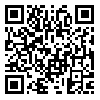BibTeX | RIS | EndNote | Medlars | ProCite | Reference Manager | RefWorks
Send citation to:
URL: http://jhsme.muq.ac.ir/article-1-61-fa.html
Background and Objectives: The aim of the present study was to determine the relationship between dimensions of religious and spiritual wellbeing, stress, anxiety, and depression in students of Qom University of Medical Sciences and as well as to access the predictability of stress, anxiety, and depression from the levels of religious-spiritual dimension in students.
Methods: In this descriptive and analytical study, 138 students in Qom University of Medical Sciences were selected via random sampling method. Theycompleted the MI RSWB- 48, Depression, anxiety, and stress scale (DASS-21). Data were analyzed by SPSS Ver.16 ,utilizing descriptive statistics and the statistical tests of Independent t-test, ANOVA, Pearson correlation coefficient and regression analysis.
Results: Religious-spiritual wellbeing was correlated with depression, anxiety and stress (p<0.05). The results of multiple liner regression showed that hope predicted stress, anxiety, and depression after controlling demographic variables. In addition, general religiosity was associated with depression.
Conclusion: The findings indicated that immanent hope and general religiosity were, respectively, the most important religious-spiritual components which may affect psychological distress in students.
| بازنشر اطلاعات | |
 |
این مقاله تحت شرایط Creative Commons Attribution-NonCommercial 4.0 International License قابل بازنشر است. |




